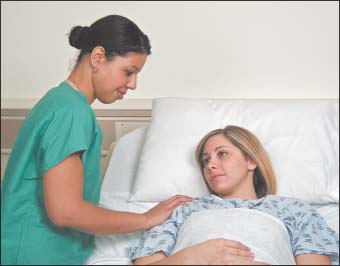Feeding
When confusion, arm or hand immobility, injury, weakness, or restrictions on activities or positions may prevent a patient from feeding himself, feeding the patient becomes a key nursing responsibility. Injured or debilitated patients may experience depression and subsequent anorexia. Meeting such patients’ nutritional needs requires determining food preferences; conducting the feeding in a friendly, unhurried manner; encouraging self-feeding to promote independence and dignity; and documenting intake and output. (See Recording fluid intake and output, page 304.)
Home Tests for Fecal Occult Blood
Most fecal occult blood tests require the patient to collect a specimen of his stool and smear some of it on a slide. In contrast, some tests don’t require the patient to handle stool, making the procedure safer and simpler. One example is a test called ColoCARE.
If the patient is to perform the ColoCARE test at home, tell him to avoid red meat and vitamin C supplements for 2 days before the test. He should check with his doctor about discontinuing any medications before the test. Some drugs that may interfere with test results include aspirin, indomethacin, corticosteroids, reserpine, dietary supplements, anticancer drugs, and anticoagulants.
Tell the patient to flush the toilet twice just before performing the test to remove any toilet-cleaning chemicals from the tank. Tell him to defecate into the toilet but to throw no toilet paper into the bowl. Within 5 minutes, he should remove the test pad from its pouch and float it printed side up on the surface of the water. Tell him to watch the pad for 15 to 30 seconds for any evidence of blue or green color changes, and have him record the result on the reply card.
Emphasize that he should perform this test with three consecutive bowel movements and then send the completed card to his doctor. However, he should call his doctor immediately if he notes a positive color change in the first test.
Equipment
Meal tray ▪ overbed table ▪ linen-saver pad or towels ▪ clean linens ▪ disinfectant ▪ flexible straws ▪ basin of water ▪ soap ▪ washcloth ▪ hand towel ▪ spoon or feeding syringe ▪ Optional: assistive feeding devices.
Implementation
Gather the appropriate equipment.
Confirm the patient’s identity using at least two patient identifiers according to your facility’s policy.4
Explain the procedure to the patient to decrease anxiety and increase cooperation.
Because many adults consider being fed demeaning, allow the patient some control over mealtime, such as letting her set the pace of the meal or decide the order in which she wants to eat various foods.
Recording Fluid Intake and Output
Accurate intake and output records help evaluate a patient’s fluid and electrolyte balance, suggest various diagnoses, and influence the choice of fluid therapy. These records are mandatory for patients with burns, renal failure, electrolyte imbalance, recent surgical procedures, heart failure, or severe vomiting and diarrhea as well as for patients receiving diuretics or corticosteroids. Intake and output records are also significant in monitoring patients with nasogastric (NG) tubes or drainage collection devices and for those receiving IV therapy.
Fluid intake comprises all fluid entering the patient’s body, including beverages, fluids contained in solid foods taken by mouth, and foods that aren’t liquid at room temperature, such as flavored gelatin, custard, ice cream, and some beverages. Additional intake includes GI instillations, bladder irrigations, fluids ingested with medications, and IV fluids.
Fluid output consists of all fluid that leaves the patient’s body, including urine, loose stools, vomitus, aspirated fluid loss, and drainage from surgical drains, NG tubes, and chest tubes.
When recording fluid intake and output, enlist the patient’s help if possible. Record amount in milliliters (mL). Measure; don’t estimate. For a small child, weigh diapers if appropriate. Monitor intake and output during each shift, and notify the doctor if amounts differ significantly over a 24-hour period. Document your findings in the appropriate location; describe any fluid restrictions and the patient’s compliance.
Raise the head of the bed if allowed (as shown below). Fowler’s or semi-Fowler’s position makes swallowing easier and reduces the risk of aspiration and choking.

Before the meal tray arrives, give the patient soap, a basin of water or a wet washcloth, and a hand towel to clean her hands. If necessary, wash her hands for her (as shown below).
Stay updated, free articles. Join our Telegram channel

Full access? Get Clinical Tree


Get Clinical Tree app for offline access
